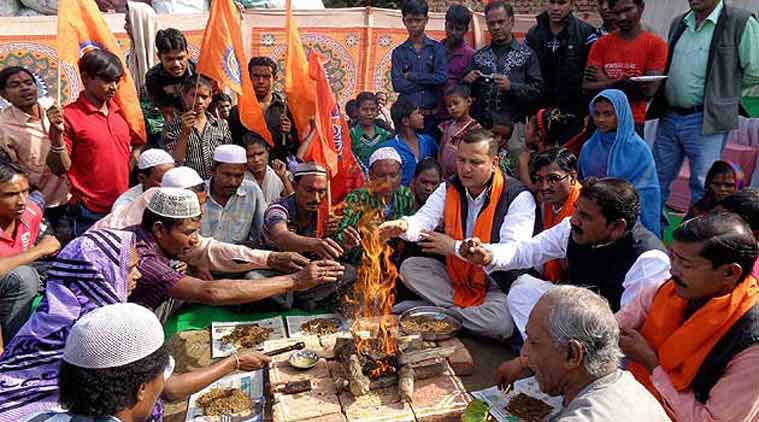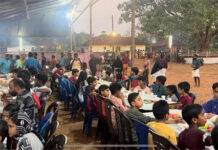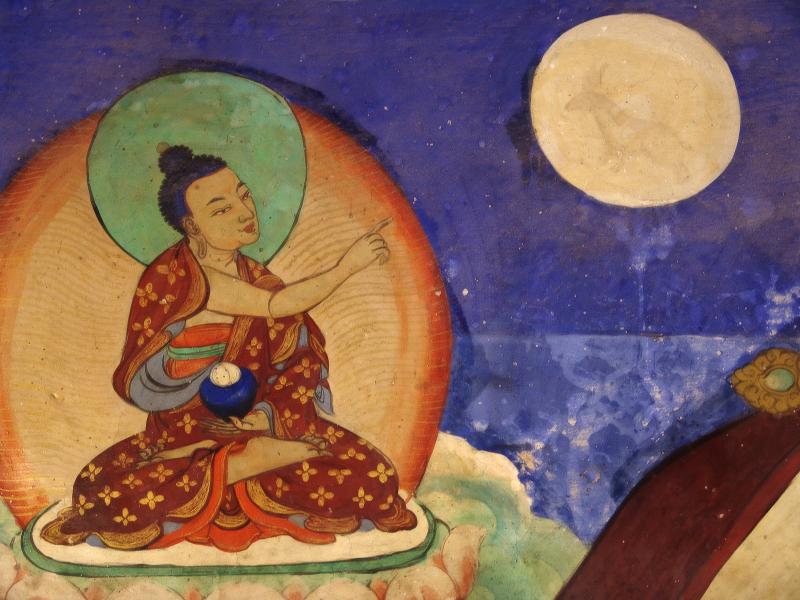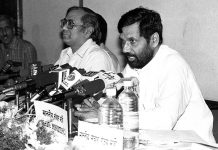
A firm commitment to secularism is needed now more than ever before in these highly troubled times when very high-level efforts to harm secularism and secular values and disturb inter-faith harmony are being made. At the same time efforts may be needed within a firmly secular framework to link religion and mythology with progressive messages of justice, peace and environment protection . In recent years there have been efforts, particularly in several oppression ridden societies, to evolve a liberation theology of various religions. This has been more discussed in the context of some Latin American countries but is not confined to them. Asghar Ali Engineer, a reputed scholar of religion as well as social reform and democratic rights writes, “Liberation theology is the need of the hour – a theology which puts great emphasis on freedom, equality and distributive justice and strongly condemns exploitation of man by man.”
However a word of caution is also required that the liberation theology we try to evolve should be fully consistent with secularism and inter-faith harmony. This should be within the framework of secularism as well as rationality. This is all the more needed in present-day troubled times. Care should be taken not to confuse mythology with history. Once all this care is taken then liberation theology can become a powerful and effective means of countering the distorted version of mythology and religion which mocks and harms secularism and inter-faith harmony while at the same time strengthening the hold of oppressive forces.
The story of Ram as told in the epic Ramayana (which has many versions) has fascinated several generations of people not just in India but in several other countries as well. Without doubt this is an extremely interesting, fascinating and in several ways inspiring story. Unfortunately powerful interests have misused aspects of this in recent times to spread inter-faith disharmony. This has been harmful for religion, society and country. Under the impact of these powerful forces and their networks the many alternative voices which present the story of Ram in a spirit of harmony and justice have been pushed to the margins. Even in terms of popular images the pictures of benevolent, protective mythological characters have been transformed increasingly into more and more aggressive looking characters, thereby challenging the basic religious heritage of peace and justice. In such a situation a liberation theology approach can be useful in the context of Hinduism and more particularly the epic of Ram.
.An important aspect of the life of Ram as given in the story of the Ramayana is that for most of the time he is shown fighting against oppression. In the first phase of the fighting against oppressor ‘rakshasas’ (demons), when the enemy was not very strong, Ram confronted them helped just by his brother, Lakshman. In the second phase, when the might of oppressor rakshasas was very great, Ram and Lakshman mobilised forest-dwellers.
At a very young age (as teenagers) Ram and Lakshman leave their palace to go to forests when they hear about the oppressive practices of rakshasas. In this episode Valmiki Ramayana and Tulsi’s Ramcharitmanas have established the importance of the fight against oppression for which any sacrifice can be made.
On crossing the Ganga river Ram and Lakshman see a badly desecrated and lonely forest area. Vishwamitra sage informs that this is the area where demons Taarka and Marich have caused havoc and inflicted sufferings on people. In the episodes which follow Ram and Lakshman throw out or kill demons such as Taarka, Marich, Subahu and their followers, thereby making the forest area safe for the sages and other people living here.
The second phase of the fight against oppression in Ramayan comes during the exile of Ram, Lakshman and Sita when they again find the forest-area under the terror and atrocities of rakshasas. Pointing to a mound of bones, Ram questions a sage about this. The sage replies that these are the bones of those sages who have been killed by the demons. On hearing this Ram vows to kill rakshasas.
Here at one point (in Valmiki Ramayan) in the conversation between Ram and Sita both of them express agreement on the point that the raison d’ etre of the Kshratriyas (warriors) taking up arms is only to protect the suffering people.
At other places, forest-dwellers (specially kol tribals) are shown to be overjoyed at the arrival of Ram, and although the reason is not clearly mentioned here, the implication keeping in view other episodes is the likelihood of help in fight against oppressors.
Although Ram and Lakshman killed Viradh and Khardhushan who were responsible for atrocities in the area through which they were passing or staying, the terror could not be permanently wiped out without confronting and defeating the main source of power of rakshasas – the kingdom of Ravan having a mighty army. So Ram decides to raise a big army to fight this bigger enemy.
After an alliance was made with Sugriv, vanar (monkey) and reechh (bear) soldiers started gathering from far away places, till a formidable army had been formed. ‘Vaanar’ is generally translated to mean monkey while ‘reechh’ is translated to mean bear. However, it should be pointed out here that in the very first reference to Sugriv, the Valmiki Ramayan describes him not as a monkey but as a man of ‘Vaanar’ caste or tribe. Thus the reference to ‘Vaanar’ and ‘reechh’ should be taken to mean not monkeys and bears but in all probability forest-dwellers, very acrobatic in their movements and very well adapted to forest habitats, and so linked to monkeys and bears for the purpose of telling an interesting story. The various references to them indicate that though extremely courageous and great fighters they had been cowed down by the rakshasas and so lived a dismal, subdued and scattered existence till they were organised. They formed a great army and from being considered the lowest of the low, they rose to defeat the mighty, very well-armed and resourceful rakshasas.
It is clear that among the several messages contained in the Ramayana the massage of fighting the oppressors and organising the weaker sections to fight the oppressors is an important message. From the justice loving people of the better-off sections it is expected that they will support the weaker sections in this fight, no matter how much they’ve to sacrifice and how many hardships they have to undergo due to this stand taken by them. Following the example of Ram. They should even be prepared to go to remote forests for this, to organise the weaker sections and contribute to the battle against oppression.
Also, the concept of Ramrajya, or the governance of Ram is presented in such a way as to emphasise reduction of poverty and protection of ecology. One important feature of Ramrajya described in Ramcharit Manas is that prosperity had also spread to the common people and poverty had been reduced. Manas says clearly about Ramrajya that no one is poor under this rule.
Manas says, “Forests are full of green and fruit bearing trees, birds sing, herds of playful animals roam around fearlessly”. “The water of all rivers was good, cool, clean and soothing.” Manas says, “To the north of the city flows the Saryu whose water is clean and deep. Beautiful ponds, baawlis and wells add to the serenity. Their stairs are so beautiful and the water so clean that even sages and angles admire them.” While praising Rajghat, a bathing place on a river bank, it has been emphasised that people of all four castes bathe here.
Also the concept of Ramrajaya is presented to be in conformity with at least some important democratic norms. In Valmiki Ramayan the most emphasis has been given on the ruler’s alertness towards public opinion and his respect for this. Ram clearly says that he cannot go against the opinion of the people of his kingdom, no matter how great the sacrifice be may have to make in his personal life for this. Further, the ruler should work very hard for the welfare of his people.
Speaking of good rule, Ram says in Valmiki Ramayan that when a case involving a dispute between a rich person and a poor person has to be decided, then special care has to be taken to ensure that money power does not influence the decision of the judge. The innocent should never be punished and the guilty never allowed to get away because of their money-power.
Despite all this, the story of Ramayana has been criticised for its alleged anti-woman and anti-dalit leanings. This criticism should be examined carefully.
The episode of exile of Sita is by far the saddest and the most controversial episode of the Ramayana. This episode sees Ram bowing to highly unjust public criticism of Sita and exiling her.
This is no doubt a grave injustice to Sita and the fact that Ram, who has been glorified in Ramayana, had agreed to it would make it appear that this epic also glorifies this act and therefore is anti-woman. But before jumping to this conclusion, certain facts have to be kept in views.
Firstly, it needs to be emphasised that this episode does not appear in Ramcharitmanas (Manas) at all, it appears only in Valmiki Ramayana and in the later it appears in Uttarakaand which according to some scholars was a later addition, not a part of the original epic.
Secondly, it is made amply clear that before this public criticism reached him Ram had been living most happily with Sita, and that the decision of exiling Sita caused him great suffering and distress but he still took it keeping in view his principle of never ignoring public opinion. While taking this decision Ram says, “I’ve fallen in the ocean of sadness …. I do not remember if I’ve ever suffered greater distress.”
More important than all the distress suffered by Ram, is the fact that within this epic this act has been condemned as highly unjust by several favoured characters, including the dearest brother of Ram, Lakshman. As Lakshman was given the sad responsibility of taking Sita to an Ashram he says that it was better for him to die than to do this work. He calls it a “cruel deed” of Ram, his elder brother whom he otherwise worshipped and wonders what sort of justification Ram could have found for this “cruel deed”.
Another extremely sad episode that occurs in Valmiki Ramayan (it is mentioned briefly in Manas also) is the criticism that Sita faces from Ram after Raavan has been defeated, and the purity test she has to undergo by agreeing to enter a fire. This is no doubt an act of extreme injustice but to judge the epic in proper perspective it should be emphasised that within its pages this act is condemned in strong words. Ram himself is apologetic about this and the act of entering fire is presented at a level which appears different from the pain normally associated with entering fire.
When Ram said bitter words to Sita, Lakshman was overcome with anger and looked at his brother with angry eyes. He could not tolerate the insult of Sita. Ram’s soldiers cried loudly at this unjust act. Angels came at the site of injustice and took Ram to task for this. The fire-god scolded Ram and ordered him never to speak anything bitter to Sita again.
It is also important that the act of entering fire here is not associated here with the pain normally associated with the touch of fire. According to Manas, before Ram embarked on fighting the powerful demons, he asked Sita to enter fire to protect herself against enemy. Sita did so, leaving only her shadow which looked and behaved like her. Thus the entire episode of entering and re-entering fire is at a different level, hence the pain, injuries etc. are not involved.
It is widely believed that Sita never protested against her husband’s actions but the fact as per Valmiki Ramayan is that Sita rebelled against Ram’s bitter words spoken soon after her release from Raavan’s captivity. She compares Ram’s conduct to that of a low person and speaks against his injustice in front of a large gathering. Thus the model of womanhood that is presented in the form of Sita is not one of unquestioning obedience, but rather one of protesting against the husband’s injustice, even if this has to be done before a large gathering and even if the husband is the king of all present.
Those who criticise Ramayana as anti-women and against the so-called low caste generally quote the lines of Manas which say that drums, animals, ruffians, low castes and women – these are deserving of punishment. What is forgotten is that these lines are being spoken in the epic by a character who has been reduced to a villainous role following his refusal to obey Ram. In no way can this be compared to the words of wisdom which the sage-poet has spoken on his own at various places in the epic or else has put them in the mouths of the favoured characters such as Ram and Sita.
Elsewhere in Manas it is written “Women are stupid by nature”, but again Goswami Tulsidas has not said this on his own. This is Sati a Goddess admonishing herself for having been less than fair. “Woman, and that too a servant, is wicked by nature” these words which appear elsewhere have been said by Kakai when speaking of Manthara and both are major villainous roles. Such examples can be extended.
Thus its is not proper to dub the Ramayana anti-women just on the basis of a few sentences quoted out of context.
Similarly about the allegation of being anti dalit, it should be pointed out that controversial episodes like the Shambuk episode in Valmiki Ramayan Uttarkaand chapter are later additions.
Still it is possible that there may be episodes in Ramayan which cannot be justified on the basis of our present-day principled stand on some issues. In such cases of course we’ve to take a critical view. But needless, out-of-context and unjustified criticism of an epic which offers substantial scope for spreading progressive messages is not proper.
Here it should be pointed out that in the case of texts which are several centuries old several such contentious issues always remain. Even in the case of some of the biggest reformers we can find a few lines here or there attributed to them which may not pass the standards of present day principles or political correctness. In such cases should we entirely discard the progressive messages of these social reformers and ignore or even criticize their important role in history? A better approach may be not to judge poets and saints and sages who lived several centuries before us by principles of our times. We should live and act according to present day needs and principles but at the same time accept gratefully the contributions made by several great sages without expecting these to be entirely in tune with present-day principles.
These and related issues are likely to come up in any efforts of liberation theology, whatever may be the religious or national context. Hence it is important also to avoid being a religious fundamentalist. If interests of justice and peace demand that we should object to some aspects of religion we should certainly do so, but we should do so only after carefully examining the context and other important aspects.
Religion is an important aspect of the life of a very large number of people. The unfortunate fact is that many powerful forces and persons do not hesitate to misuse religion to spread conflict and violence and to justify exploitation and oppression. Should they go unchallenged, or should others committed to peace and justice try to present an alternative vision of religion and mythology? It is in this wider context that the task of evolving liberation theology should be examined.
Bharat Dogra is a free-lance journalist and author who has written widely on peace and the need for inter-faith harmony. His latest book is Vimla and Sunderlal Bahuguna—Chipko Movement and the Struggle Against Tehri Dam Project in Garhwal Himalaya.










